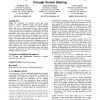5 search results - page 1 / 1 » Controlling interruptions: awareness displays and social mot... |
CSCW
2004
ACM
14 years 2 months ago
2004
ACM
Spontaneous communication is common in the workplace but can be disruptive. Such communication usually benefits the initiator more than the target of an interruption. Previous res...
ISR
2008
13 years 9 months ago
2008
s displays harmed interrupters' task performance, while abstract displays did not. We conclude that y with an abstract representation of a collaborator's workload is opti...
CSCW
2006
ACM
14 years 3 months ago
2006
ACM
Despite the availability of awareness servers and casual interaction systems, distributed groups still cannot maintain artifact awareness – the easy awareness of the documents, ...
CSCW
2006
ACM
13 years 11 months ago
2006
ACM
Code management systems like Concurrent Version System (CVS) can play an important role in supporting coordination in software development, but often at some time removed from ori...
CSCW
2007
ACM
13 years 9 months ago
2007
ACM
To date the most popular and sophisticated types of virtual worlds can be found in the area of video gaming, especially in the genre of Massively Multiplayer Online Role Playing Ga...

